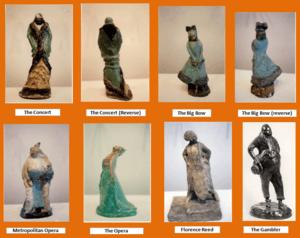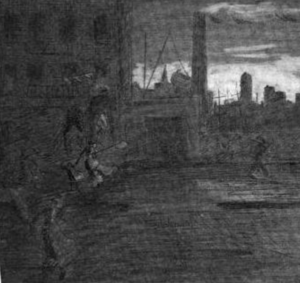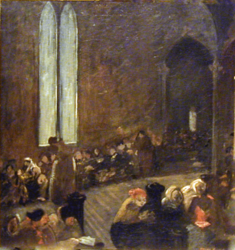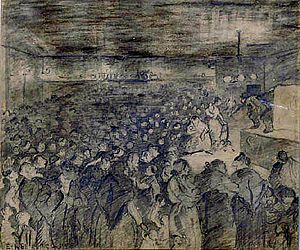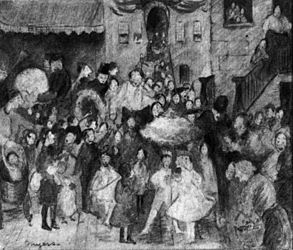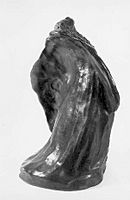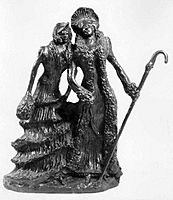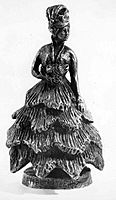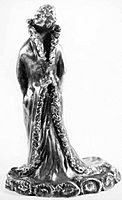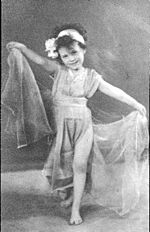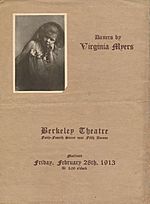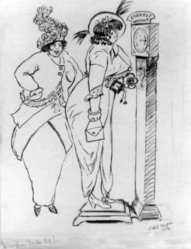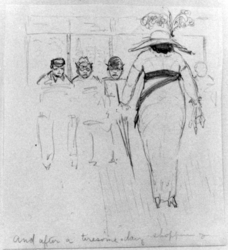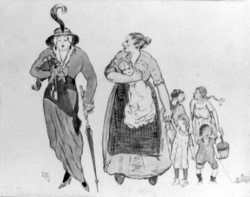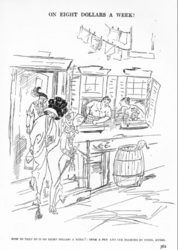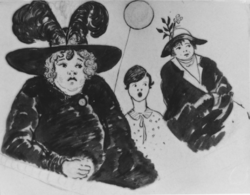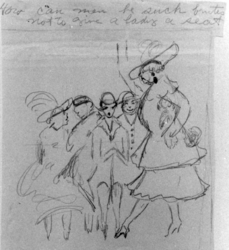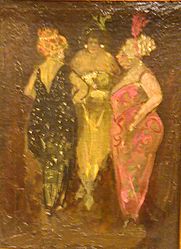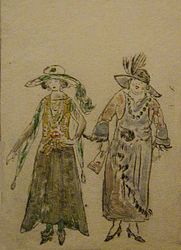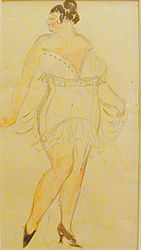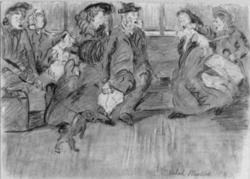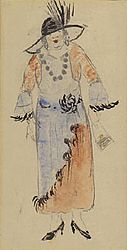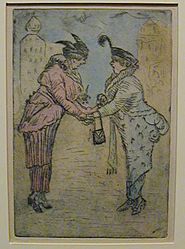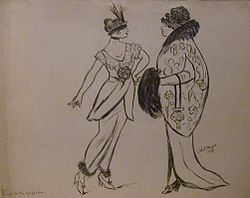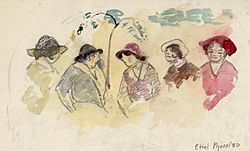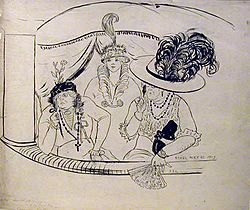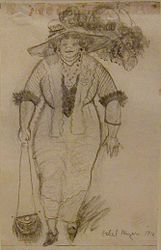Ethel Myers facts for kids
Quick facts for kids
Ethel Myers
|
|
|---|---|
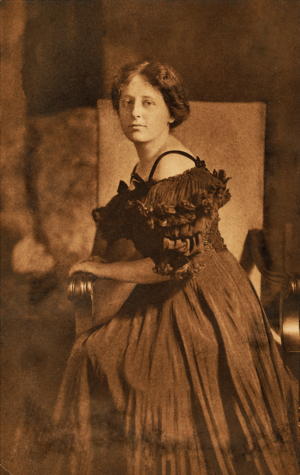
Ethel Myers, 1908
|
|
| Born |
Lillian Cochran
August 23, 1881 |
| Died | May 24, 1960 (aged 78) |
| Nationality | American |
| Education | The Chase School, New York School of Art |
| Known for | Sculpture, Drawings, Paintings, Entrepreneur, Fashion Designer, Educator, Lecturer |
|
Notable work
|
The Matron, The Gambler (Joe Johnson), Florence Reed, Encounter, Ambulance Call |
| Movement | New York Realists, Ashcan School |
| Spouse(s) | Jerome Myers |
Mae Ethel Klinck Myers (born August 23, 1881 – died May 24, 1960), known as Ethel Myers, was an American artist and sculptor. She was part of the New York Realists and was greatly inspired by the Ashcan School. This art group focused on showing everyday life in cities.
Ethel Myers first painted scenes of busy city areas like the Lower East Side in New York. She also visited similar neighborhoods in other cities. Later, after marrying artist Jerome Myers, she became famous for her small bronze statues. These statues often showed people with a funny touch and a strong sense of life. People said her sculptures were full of movement and very convincing.
Contents
Ethel's Early Life and Education
Ethel Myers was born Lillian Cochran in Brooklyn, New York, in 1881. Her birth mother passed away when Ethel was only four years old. Her father had also died, leaving her an orphan. She was then adopted by Michael and Alfiata Klinck, a wealthy couple who renamed her Mae Ethel Klinck.
After Michael Klinck died, Alfiata moved between Brooklyn and Orange, New Jersey. This allowed Ethel to get a good education in both public and private schools. Her adoptive mother also wanted Ethel to become a concert pianist. However, Ethel found piano lessons boring.
Ethel decided she wanted to be a painter instead. She left high school and tried to get into the National Academy in New York City. She didn't pass the first time but was encouraged to try again. Instead, she went to the Chase School. There, she became a class monitor and later an assistant director and teacher. She even helped bring the famous artist Robert Henri to the school, which was then called the New York School of Art.
Ethel studied at the Chase School and the New York School of Art from 1898 to 1904. She was a favorite student of William Merritt Chase. She also learned from Robert Henri, who had a big impact on her early art. She studied alongside other well-known artists like Edward Hopper and Joseph Stella. She also met painters such as George Luks and John Sloan.
Early Career and the Ashcan School
Ethel Myers was deeply inspired by the ideas of Robert Henri, her teacher. Henri encouraged his students to paint real life, especially the lives of ordinary people in cities.
Ethel focused on studying the lives of people in city slums. She spent time in the Jewish district of New York City, sketching scenes from daily life. She also visited Italian and Hebrew neighborhoods in Boston. Ethel found that the best way to capture these scenes was to observe them carefully and remember them. She would then draw them later from memory.
She often dressed like the people she wanted to observe and mixed in with them. She especially liked to make friends with children and watch their games. Ethel planned to compare the slums in different cities across the country.
Ethel's Early Artwork
Family Life
Marriage to Jerome Myers
Ethel first met Jerome Myers, who would become her husband, in 1904. She admired his paintings and drawings of the Lower East Side. Critics and artists, especially Robert Henri, respected Jerome for showing the lives of immigrants with honesty. Henri believed that art should be connected to life.
Ethel arranged to meet Jerome in his studio. They visited each other's studios several times. Ethel wrote that marriage was not on her mind, but Jerome proposed after three months. He told her he didn't have much money. Ethel was surprised because she was already engaged to someone else. She thought about it for a week and decided to marry Jerome.
Jerome Myers and Ethel Klinck got married in a small church ceremony in October 1905. They started their married life in his studio.
Family Challenges
Ethel's adoptive mother did not approve of her marriage to Jerome because he was a poor artist. She preferred Ethel's earlier engagement to a businessman. Because of this, Ethel's mother cut her off from a large inheritance she had been promised.
A year after they married, on October 21, 1906, Ethel gave birth to their daughter, Virginia Myers. It was a very difficult birth. Soon after Virginia was born, Ethel received a note from her adoptive mother. Her mother offered to give Ethel the full inheritance if she would leave Jerome and the baby and come back to live with her. Ethel never replied to the offer.
Artistic Shift and Recognition
After her daughter was born, Ethel made an important career choice. She decided to stop painting and focus on creating small, realistic sculptures instead. This helped free up studio space for her husband, Jerome. It also prevented people from comparing her work directly to Jerome's, since they would be working in different art forms.
Ethel Myers became known for her bronze sculptures of city people. These sculptures often showed humorous scenes. She showed nine of her sculptures in the famous 1913 Armory Show. This show introduced modern art to America. Art historians now say that Myers was one of the most creative American artists in that show.
Positive Reviews for Her Sculptures
Ethel's sculptures received many good reviews from art critics. They praised her humor and her ability to capture real life.
The Craftsman magazine said that Ethel, who was known as a painter, would now be seen as a sculptor with a great understanding of human life. The New York Times called her a "serious humorist." Other newspapers like The Brooklyn Eagle and New York Herald-Tribune also praised her figures for being expressive and full of life. Vogue Magazine called her work "unique and charming."
Even famous people like Theodore Roosevelt, who visited the 1913 Armory Show, admired her work. He mentioned her sculpture called 'Gossip' and compared it to classic Greek stories that showed everyday life.
Bronze Statuettes by Ethel Myers
Ethel as a Publicist and Manager
Around 1909, Ethel's daughter Virginia, then three years old, showed great artistic talent. One day, while Ethel played the piano, Virginia began dancing naturally to the music. This was a time when the dancer Isadora Duncan was very popular. Ethel noticed Virginia's gift for spontaneous dance movements. She encouraged her daughter to perform.
When Virginia was five, she starred in an Edison film called Dream Dances of Virginia Myers. She performed 20 minutes of her own dances. This film helped make her famous across America. In 1913, Vogue Magazine featured her in an article titled "When Virginia Dances," calling her "a child of the century."
Virginia's performances started in the Myers' small studio for friends. Soon, they needed bigger places. Even with limited money, Ethel took on all the management for Virginia's growing career. She organized many recitals in New York City. She handled booking theaters, contracts, costumes, set design, musicians, and publicity.
Virginia became known as a "child wonder" of dance. People came from everywhere to see her. Ethel and Jerome organized seventeen recitals in New York City theaters. Many articles were written about Virginia's dancing talent. When she was 16, she was finally allowed to perform as a star on the main stage at Carnegie Hall. She had her first solo performance there with an orchestra in April 1923, and a second in December 1923.
Challenges After the Armory Show
Even though Ethel had personal success at the 1913 Armory Show, the event did not help American art as much as Jerome Myers had hoped. Instead, the show mostly focused on European modern artists like Gauguin, Cézanne, and Picasso.
Jerome had worked for a year to prepare the American part of the show without pay. After the show, Ethel said they were "dead broke." She organized an exhibition of Jerome's work and sold everything for half price because they planned to go to Europe. They knew the Armory Show would make it harder for American artists to sell their work. Art dealers would be more interested in European art.
Journey to Europe and World War I
An English art curator, Roger Fry, had bought some of Jerome's drawings. He told Jerome to go to London, believing he would find a good market there. So, in 1914, the Myers family traveled to London with two trunks full of art. The New York Times reported that Jerome Myers would be painting in London and Paris. This was on June 28, 1914. Exactly one month later, World War I began.
After leaving some art with their dealer in London, the Myers family went to Paris. They rented an apartment, bought furniture, and hoped for a new beginning. Jerome started working, and they made plans for their 8-year-old daughter Virginia to perform her dances in a Paris theater.
However, the war shattered their plans. The American Embassy told Jerome and Ethel to leave Paris immediately. They had to pack quickly, leaving their apartment and furniture. With two taxis full of trunks, unfinished paintings, and wet laundry, and almost no money, the Myers family began a frightening journey back to America.
Return to America and New Ventures
Jerome, Ethel, and Virginia were exhausted and nearly starving on their journey back to America. They had traveled day and night on the ship's deck due to crowded wartime conditions. Seeing the Statue of Liberty in New York harbor must have brought them great joy, much like the immigrants Jerome often painted. Their hope that Europe would change their fortunes did not come true.
At this difficult time, Ethel decided she needed to help support her family by finding new ways to earn money. She turned her attention to the fashion industry. This didn't mean she stopped her art entirely. She still found ways to express herself by observing New York life.
Ethel Myers believed that women's fashion was like a "human comedy." She found inspiration in the people she saw every day on the streets of New York.
Businesswoman, Designer, and Educator
Ethel Myers strongly believed in her husband's art career. She often put her own artwork aside to start businesses that would help her family financially. These activities included fashion design and teaching. She worked as a businesswoman for about 25 years, from 1915 until Jerome's death in 1940.
After returning to New York, Ethel decided to become a clothes designer. She bought lace with five dollars, designed a blouse, and sold it to a Fifth Avenue shop. From then on, she was in business. She designed women's clothes and hats, running a shop in New York City from 1920 to 1940. She designed clothes for famous people in society, theater, and opera.
After her husband died in 1940, Ethel focused on promoting his art. She gave lectures about Jerome's work across the United States from 1941 to 1943. She also managed the Jerome Myers Memorial Gallery in New York City for several years.
From 1949 until she retired in 1959, Ethel was the Art Director of the Fine Arts and Ceramics Department at Christodora House in New York City.


